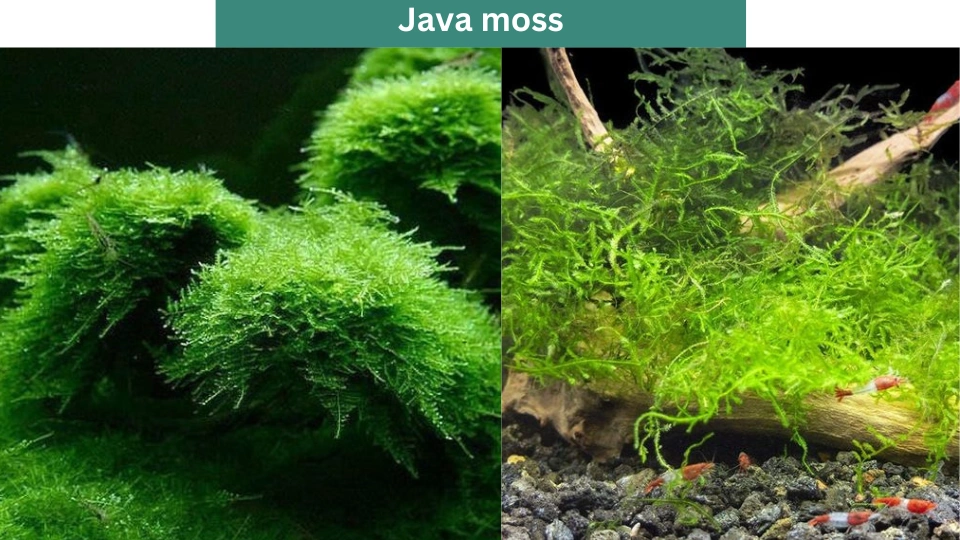Last Updated on March 14, 2024 by Aftab Tariq
Java moss, a frequently utilized aquatic plant in fish tank decoration and aquascaping is renowned for its ease of care and adaptability. It serves as an excellent option for novice aquarists due to its simple cultivation requirements, compatibility with a wide range of fish species, and minimal maintenance needs. Dr. William says,
“As Java moss carpets the aquatic landscape, it weaves a tapestry of vibrant green, inviting aquarists into a world where slow growth mirrors the patient rhythm of life beneath the surface.”
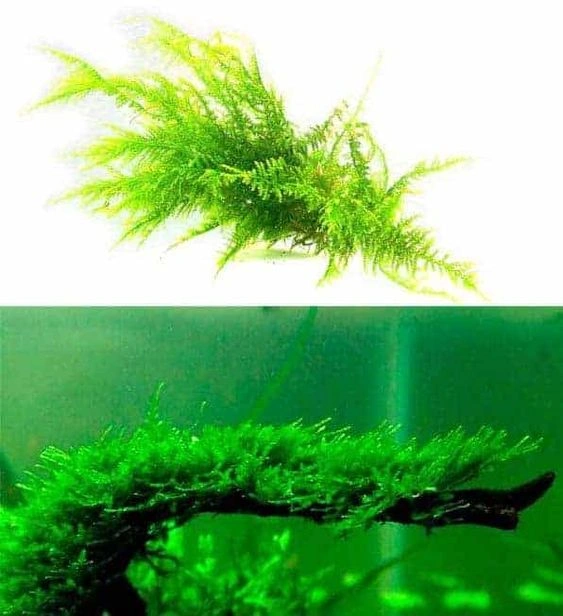
Java moss, a type of freshwater plant from the Hypnaceae family, is often used in aquariums to create a beautiful underwater landscape. It grows in shades of green and has a furry texture, with many tiny stems. This plant is easy to take care of and is loved by aquarium enthusiasts because it helps create a natural look in the tank.
Origin of Java moss
Java moss comes from places like Southeast Asia, including countries like Japan, Singapore, and Vietnam. It also grows in places like Java Island, Malaysia, and the Philippines. You can find this plant growing on land and underwater. It likes moist, tropical areas and often grows on rocks, riverbanks, and tree trunks.
Java moss is very common in the wild, especially in water or near water. It can grow on almost anything, like driftwood, gravel, and even the top of the water itself.
| Scientific Name | Taxiphyllum barbieri |
| Common Names | Java moss, Bogor moss |
| Origin | Southeast Asia |
| Height | 2–4 inches |
| Growth Rate | Slow (1–1.5 inches per month) |
| Color | Bright green |
| Aquarium Placement | Carpeting |
| Water Type | Freshwater |
| Temperature | 60–80°F (15–27°C) |
| pH | 5.0–8.0 |
Appearance And Size Of Java Moss
Java moss is a vibrant green plant with lots of leaves packed closely together, making it look like a thick carpet. Its stems are short, usually not taller than 4 inches, and they’re covered in tiny leaves that are about 0.7 inches long.
Unlike many other plants, Java moss doesn’t have roots. Instead, it sticks to things with tiny sticky “feet” called rhizoids, which help it stay in place. It grows slowly, only about 1 to 1.5 inches each month.
When it’s growing underwater, Java moss has smaller and greener leaves compared to when it’s growing on land. Also, newly planted moss looks brighter than older moss.
Suitable Tank Companions
Java moss is great for tanks with any kind of freshwater fish. It’s especially loved by fish and other creatures that like to nibble on plants or hang out at the bottom of the tank. Some good tank mates for Java moss include:
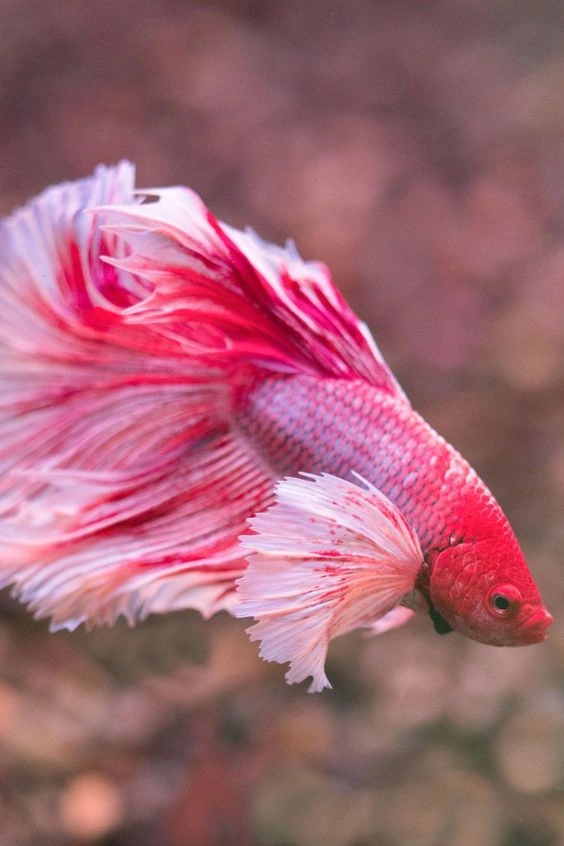
- Source : Pinterest
- Bristlenose plecos
- Chinese algae eaters
- Siamese algae eaters
- Cherry shrimp
- Amano shrimp
- Nerite snails
- Angelfish
- Cichlids
- Betta fish
You can plant Java moss with other aquarium plants without worrying about it affecting their growth.
Conditions And Requirements For Java Moss Aquarium
Caring for Java moss in aquarium is simple. This plant can thrive in various water conditions found in the wild, preferring water with a decent flow, warm temperatures, and a balanced pH level. Java moss doesn’t require a specific type of ground because it’s lightweight and can attach itself to any surface.
1: Tank Setup
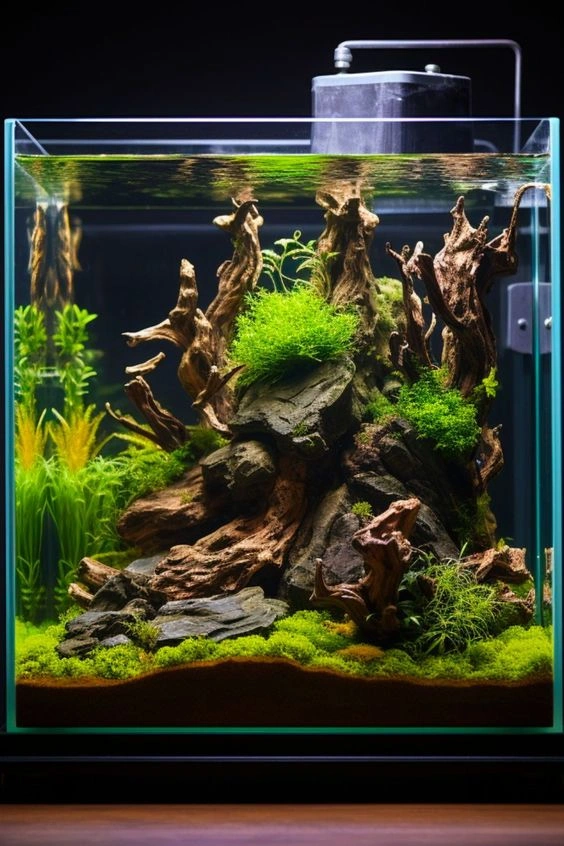
When growing java moss underwater, it’s essential to create conditions similar to its natural environment in Southeast Asia. Java moss needs something to cling to, but it’s not particular — it can grow on gravel, driftwood, rocks, glass, or tank decorations. Providing moderate or dim lighting for 8–10 hours daily is enough as the moss is accustomed to shady environments in the wild. While bright light can make the plant grow denser, it may also lead to more algae growth. Java moss thrives in moderately warm water, ideally around 75°F, although it can tolerate temperatures up to 86°F.
2: Tank Conditions
The Java moss can handle changes in water conditions pretty well.

| Parameter | Specifications |
| Water type | Freshwater, slightly acidic to neutral |
| Tank size | Minimum 5 gallons |
| Water temperature | 59–86°F |
| Required substrate | Not necessary, grow on any surface |
| Tank placement | Carpeting |
| Acidity | pH 5.0–8.0 |
| Water hardness | 6–20 dGH |
| Light type & strength | Low to moderate aquarium lighting |
| Hours of light | Approximately 10 hours |
| Water heater | Not essential |
But it grows fastest when the aquarium has enough carbon dioxide and the water is kept clean.
Optimal Tank Positioning And Aquascape Design
Since Java moss doesn’t have roots, you can grow it on various surfaces inside the tank, both horizontally and vertically. It’s easy to use it as a carpet at the bottom of the tank. Because the moss grows thick and short, it’s great for hiding things in the tank that don’t look nice, like plastic decorations.
People often use this moss for aquascaping, which means arranging plants and decorations in an aquarium. It looks nice when it’s grown on a piece of driftwood that’s set up in the tank to look like a small tree. But you need to trim it regularly because it can spread quickly.
Designing A Java Moss Mat Or Wall

A popular way to grow Java moss is by making a carpet or wall in your tank. This gives your tank a nice looking floor or wall and is easy to take care of. To make a carpet, you’ll need two pieces of mesh and some fishing line or thread. It’s important to make sure all the stuff you use in your tank is safe for the fish.
First, lay down one piece of mesh and gently spread Java moss on top. You can cut it into pieces to make it sit flat; it doesn’t have to stay in one big piece. Once you’ve covered the mesh nicely, put the second piece of mesh on top and use thread to tie them together. Now, put this sandwiched moss into the tank.
Over time, the moss will grow through the mesh, giving you a beautiful bed of moss that covers the floor or wall. Another way to grow the moss is by making a carpet. To do this, sprinkle a bit of gravel over the moss to hold it down as it sticks to the tank floor.
Crafting Java Moss Arboreal Features
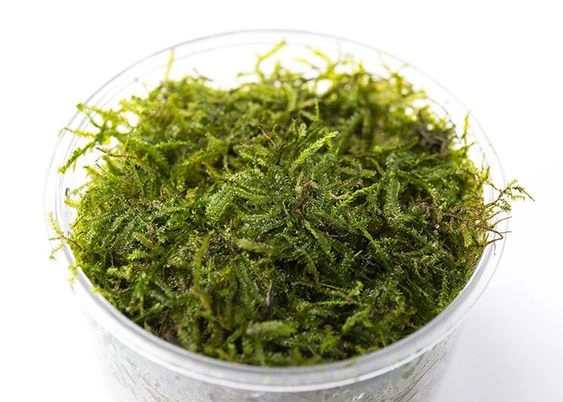
You can make trees with Java moss. First, find a piece of driftwood that stands up straight. It should look a bit like a tree trunk with branches. Another way is to tie several pieces of wood together to make a tree shape. Use glue that’s safe for fish tanks.
1: Get your Java moss. If you took it from your tank, gently pat it dry.
2: Using a little glue, stick the moss onto the branches. Trim any extra bits to make it look like a tree.
3: Put your moss tree in your tank.
How To Establish Java Moss In An Aquarium?

Before adding Java moss to your aquarium, it’s important to clean it first. This helps remove any pests or algae that might be on the plant. You can do this by soaking the moss in a bleach mixture.
If your Java moss came attached to something like driftwood, carefully remove it before cleaning the moss. Then, follow the cleaning steps mentioned earlier.
How To Add Java Moss To Your Tank Safely?
Adding Java moss to your tank safely involves a few simple steps:
1: Start by putting the Java moss in a bucket of clean water.
2: Get two more buckets, some cleaning gloves, unscented bleach, a de chlorinator, and tap water.
3: In one bucket, mix one part bleach with 20 parts tap water. In the second bucket, add water and the recommended amount of de chlorinated according to the instructions on the product.
4: Wear your cleaning gloves and fully dip the moss into the bleach water mix for 90 seconds.
5: After that, move the moss quickly to the bucket with a de chlorinator and let it soak for about five minutes.
6: Finally, transfer the moss to your tank.
Java Moss Growth Rate
Java moss can grow fast if it gets enough light, the right water, and plenty of nutrients. It usually takes about 3 to 4 weeks for Java moss to start growing and settle in. During this time, it can grow up to 1 to 1.5 inches every month.
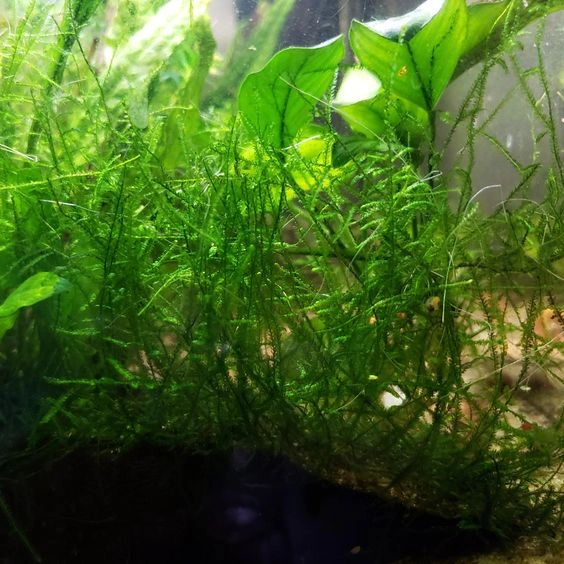
Java Moss On Driftwood
Java moss is often used to cover rocks or driftwood in aquariums. This gives a natural and aged appearance that many people like. It’s also useful in breeding projects because it provides good hiding spots for baby fish, called fry.
How To Plant Java Moss?
To plant Java moss, first, divide it into small pieces about 2 inches long. This lets more light reach the leaves and stems, helping the moss grow faster. Put these pieces on the bottom of your aquarium, on a rock, or any flat surface. Give it a few days to hold onto the surface.
If you’re planting Java moss on tricky surfaces like curved driftwood, you can use fishing wire to hold it in place. Keep the wire there until the moss sticks on its own. Then, you can cut the wire with scissors.
Java Moss Care
Mosses native to Java are tough plants that thrive in a wide range of water environments. They don’t require any particular food or water conditions, and they don’t grow to be too big for the tank, so they’re easy to maintain.
Nutrition: Java moss can grow faster with extra fertilizer and CO2. But if it lives with fish, it doesn’t need these extra nutrients. Using too much can lead to hair algae growing, which isn’t good.
Maintenance: Java moss doesn’t get plant diseases, but there are some problems to watch out for:
Dirt Buildup: The moss’s leaves can collect leftover food and fish waste, making the tank dirty. To clean it, take out the moss covered objects and rinse them in cool water. If you can’t remove it, use a tube to suck out the dirt.
Algae Growth: Algae often grow on Java moss, especially in bright light. It grows faster than the moss, making it hard to remove. To stop algae, add fish or invertebrates that eat algae. But make sure they get along with your other tank buddies.
Leaf Browning: If Java moss doesn’t get enough nutrients, light, or clean water, it turns brown. To keep it healthy, add a little fish friendly fertilizer, control algae, add more carbon dioxide if needed, and make sure the water and light are just right.
Overgrowth: Trimming Java moss stops it from taking over the tank. Cut it into a neat carpet with scissors whenever it starts growing too much. This keeps it looking tidy and helps it grow better.
Propagating Java Moss
Propagating Java moss is simple with these steps:
1: Trimming: Use scissors to cut a 2 inch piece of the plant.
2: Placement: Put the plant piece on a surface where you want new Java moss. If it doesn’t stay put, use a fishing wire to hold it in place.
3: Attachment: The plant piece will naturally stick and start spreading within three weeks. Once it’s attached well, you can remove the fishing wire.
What Is Java Moss Good For?
Java moss is a tough and colorful plant that adds beauty to your aquarium at home. You might want to get this plant if you’re interested in decorating your tank with inexpensive and low maintenance plants.
However, if you don’t have ways to manage algae growth, you might want to skip Java moss. It can attract algae easily.
Overall, Java moss is great for both newbies and seasoned aquarium enthusiasts. It’s pretty, practical, and simple to take care of.
Is Java Moss Hard To Grow?
Growing Java Moss is incredibly easy. This moss is tough, adaptable, and stunning. It effortlessly brings a lush green to your aquarium. Keeping it alive is a breeze you’d have to put in more effort to harm it than to nurture it.
Does Java Moss Produce Oxygen?
Yes, Java moss does produce oxygen. Similar to other plants, Java moss creates oxygen as a result of photosynthesis. This process also helps decrease CO2 levels in the tank, making the water cleaner and better for other creatures in the aquarium.
Does Java Moss Need CO2?
Java Moss can thrive without additional CO2 if it’s grown under medium or low light conditions. However, providing CO2 can boost its health and growth rate. With CO2 supplementation, Java Moss grows faster and it’s easier to achieve the desired appearance.
Java Moss Benefits
Java Moss offers numerous benefits, from oxygen production to water filtration, and adds to the aesthetic appeal of your aquarium while being easy to propagate and maintain.
1: Oxygen Production: Java Moss, like other plants, produces oxygen through photosynthesis, ensuring a healthy oxygen level for your fish to breathe. This enhances the overall oxygenation of your tank.
2: Attractive Appearance: Java Moss adds visual appeal to your tank, creating a natural and pleasing scenery. It can be used as a carpeting plant to cover the tank floor or as a floating plant, adding beauty to your aquatic environment.
3: Natural Water Filter: Acting as a natural water filter, Java Moss helps reduce harmful levels of ammonia, nitrite, phosphate, and nitrate in the water, thereby improving water quality and clarity. This creates a healthier habitat for fish and plants.
4: Easy Propagation: Java Moss is simple to propagate. You can cut it into small pieces and attach them to driftwood, rocks, or other substrates. With minimal care, these baby Java Mosses can grow, expanding your plant population.
5: Dirt Accumulation: Java Moss collects dust and dirt particles, making cleaning the tank easier. It helps maintain the visual clarity of the tank water by regulating dirt accumulation.
How To Grow Java Moss Fast?
Here are tips to know how to grow java moss? Temperatures of 70 to 75 degrees Fahrenheit are ideal for the rapid growth of Java moss. To ensure that the water reaches every area of the plant, use air stones to create water movement. To avoid algae, cultivate them in low light conditions and add liquid CO2 and fertilizer after one week.
Temperatures
The temperature range to which Java moss may adapt is quite wide. Temperatures as high as 86 degrees Fahrenheit can not stop it from growing. However, in this scenario, the growth of Java moss will be reduced.
Raising the water temperature will hasten the growth of java moss. Too hot is anything above 75 degrees Fahrenheit. Accelerate growth by lowering the temperature.
Add In Air Stones
Put the java moss in the role of the aquatic dancer. It is restless by nature. To ensure that all parts of the plant receive oxygen, it favors swaying its leaves in different directions. The growth rate is reduced when airflow is limited.
The easiest way to increase blood flow is with air stones.
The water in aquariums already contains oxygen. As a result, plants will remain alive. Avoid mistaking pumps for devices that increase air circulation. Those merely add oxygen to it.
Even if you place Java moss on rocks or driftwood in a secluded area of your aquarium, it may not get the air circulation it needs to flourish.
If your blood flow is low, try dropping an air stone or two. The plant’s leaves will wilt and scatter as a result of the bubbles.
Fertilizer
You can increase the rate of growth by adding liquid carbon dioxide to the water. Nevertheless, as long as the water is free of algae, java moss can grow rapidly even without it.
Algae will most certainly become an issue if you cultivate it in a very bright light, which is discussed further down. When plants are grown in bright light, they use fertilizer more effectively.
Regrettably, algae are a downside to java moss. Instead of feeding the plant, the fertilizer would feed the algae, creating more issues than it would solve.
Fast Growth Lighting Needs
It is best to work in dim to medium light. Indeed, photosynthesis is their growth mechanism.
The growth rate of java moss will not be accelerated by increasing the light. However, algae thrive in bright light and will draw water nutrients, starving the moss of its growth fuel.
Java moss doesn’t have any particular light needs. Java moss may thrive in any kind of light. Moss can tolerate a wide variety of light levels, making LED plants a good investment for this plant.
LEDs are more than enough to provide respectable light output while dissipating almost no heat. They keep the water temps from being too radically changed by the light.
You can also use fluorescent lights, but an LED light will be more than enough to develop java moss without attracting any other types of algae or fungi.
Java Moss Vs Christmas Moss
Java moss has a straight and slender appearance, whereas Christmas moss fronds are wider at the base and narrow towards the tip, resembling a traditional Christmas tree shape. Other variations between Christmas moss and Java moss include the cellular structure: Christmas moss has broader cells with thin walls compared to Java moss.
Java Moss For Sale
You can easily find Java moss in pet stores and online. It’s widely available and doesn’t cost much, usually between $5 to $15 depending on how much you want. You can buy it on websites like Etsy and Amazon, or at stores that specialize in aquarium supplies.
Frequently Asked Questions
Can You Grow Java Moss On Land?
Yes, Java Moss can indeed grow on land, provided the environment is suitable. While it’s naturally found in aquatic settings, Java Moss can thrive in conditions with over 80% humidity. Its adaptability allows it to survive and even flourish outside of water, making it a versatile plant option for various setups.
What Is Java Moss Price?
Java moss price is between $1095 $10.95.
Source
Java Moss: Care & How to Plant and Grow
Java Moss Care Guide: Essential Tips for a Healthy Aquarium Plant
I am a dedicated content writer with more than five years of experience, particularly skilled in the art of storytelling. My writing journey commenced during my college years, where I pursued journalism and unearthed my talent for creating captivating narratives.

